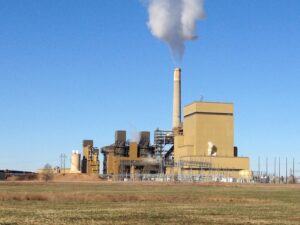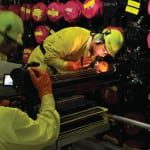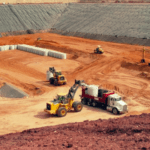A group of U.S. lawmakers has asked Canadian Prime Minister Justin Trudeau to reconsider that country’s proposed plan to store its nuclear waste at a site near Lake Huron, northeast of Detroit, Michigan.
The site, at Huron-Konloss/South Bruce, in Bruce County, Ontario, is one of two communities chosen by the Nuclear Waste Management Organization (NWMO), which consists of Canada’s nuclear power generating companies and includes Ontario Power Generation, New Brunswick Power Corp., and Hydro-Quebec. The NWMO was established by Canada’s parliament in 2002, and is responsible for designing and implementing the country’s plan for the long-term management of used nuclear fuel.
Bruce County is home to Ontario Power Generation’s Bruce Nuclear Generation Station, the country’s largest nuclear power plant with more than 6 GW of generation capacity. The station, known as Bruce Power, has eight reactors, the most of any operating nuclear station worldwide. It was chosen as a POWER Top Plant in 2013.
The two sites were chosen last week from among five areas considered by the NWMO. The second site is at Ignace, a rural town in northwest Ontario about 150 miles north of western Lake Superior.
Canada has an inventory of about 2.9 million bundles of used nuclear fuel. The waste at present—government data shows it’s about 128 million pounds of radioactive material—is stored above-ground in wet pools and dry containers at the nuclear plants where the fuel is used.
The site chosen near Lake Huron is in the same general area where a previous underground storage facility, designed to hold low-to-intermediate-level radioactive waste from Ontario’s 19 nuclear reactors, was proposed a few years ago. That plan remains under consideration although it has always been met with vocal opposition from officials across the Great Lakes Basin, particularly in Michigan.
Canadian officials have said the Bruce County site is suitable for a large waste repository, at least 1,650 feet or more underground. Officials said it could house the entirety of Canada’s spent nuclear fuel.
The U.S. has been looking for a permanent home for its nuclear waste for decades. A proposal to establish a site at Yucca Mountain in Nevada has been stalled for years. Several other countries, including Finland, France, and Sweden, are designing deep geologic repositories for their spent nuclear fuel.
A bipartisan group of U.S. House members from Michigan wrote a letter dated Dec. 6 to Trudeau. The letter, signed by Democratic Reps. Debbie Dingell and Dan Kildee, along with Republican Reps. Fred Upton and Paul Mitchell, said, “We stand in strong opposition to any decision by the Canadian government to select or consider a permanent national repository for nuclear waste storage anywhere near the Great Lakes. This is a treasured natural resource each of our countries share and we urge you to stand with us to protect these waters for future generations.”
The House Energy and Commerce Committee in November approved an amendment introduced by Dingell and Upton expressing the sense of Congress that the United States and Canada should not allow long-term storage of spent nuclear fuel or other radioactive waste near the Great Lakes. Michigan’s Democratic U.S. senators, who previously have argued against even lower-radiation nuclear waste storage near the Great Lakes, told The Detroit News they are “extremely concerned” about the new proposal.
“This makes no sense,” Sen. Debbie Stabenow told the newspaper. “Canada has as much at stake as we do in protecting our Great Lakes. There is no justification for a nuclear waste site so close to Lake Huron to even be under consideration.” Stabenow said she would contact Canadian officials to discuss the issue.
Sen. Gary Peters said the Great Lakes provide drinking water to 40 million people on both sides of the U.S.-Canada border. “That’s why we need to do everything we can to protect the Great Lakes for future generations,” he told the News. “I am extremely concerned about the possibility of hazardous nuclear waste being stored near the Great Lakes. Any accident could have catastrophic and long-term consequences to the health and well-being of Michigan and the country. I urge the Nuclear Waste Management Organization in Canada to reconsider naming a finalist location so close to the Great Lakes.”
Ben Belfadhel, vice president of site selection at NWMO, told media the idea for a “deep geologic repository” of nuclear waste came out of a nationwide process asking Canadians what to do about the country’s nuclear waste. Belfadhel said an underground storage “is the safest method we have today to ensure the safe, long-term management of used nuclear fuel. It is a method that’s being pursued by all countries around the world with nuclear programs.”
The NWMO said 22 Canadian communities initially expressed interest in learning more about being host to a waste site. Belfadhel said three main criteria led the evaluation of potential host communities: confidence the NWMO could safety operate a facility there; confidence high-level radioactive waste could be transported to the site in a “safe, secure, and socially acceptable” way; and the possibility of a partnership with cities, towns, and any indigenous communities in the proposed project area.
Belfadhel said the Lake Huron and Ignace sites “are the communities that satisfied best the three criteria: safety, transportation and the potential for partnership. If you look at what we have today, used nuclear fuel and other radioactive material is sitting on the shores of the Great Lakes. Interim facilities are safely managed and are well-regulated. But those facilities, they require maintenance. Used nuclear fuel is going to remain hazardous for hundreds of thousands of years. We have no guarantee today that our society is going to remain stable to maintain those surface facilities. We need an underground, passive solution.”
Belfadhel said environmental studies and geological evaluations, along with public input, are needed before either of the two proposed waste sites is chosen.
—Darrell Proctor is a POWER associate editor (@DarrellProctor1, @POWERmagazine).










